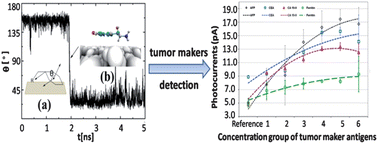Unlabeled multi tumor marker detection system based on bioinitiated light addressable potentiometric sensor†
Abstract
Multi

* Corresponding authors
a
College of Information Science Technology, Nankai University, China
E-mail:
jiayunfang@yahoo.com.cn
Fax: +86 22 23501565
Tel: +86 22 23501565
b
State Key Laboratory of Medicinal Chemical Biology, College of Life Science, Nankai University, China
E-mail:
xzfeng@nankai.edu.cn
Fax: +86 22 2350 7022
Tel: +86 22 23507022
c College of Chemistry, Nankai University, Tianjin, China
d School of Medicine, Nankai University, Tianjin 300071, China
e College of Biomedical and Bioengineering, Tianjin Medical University, China
Multi

 Please wait while we load your content...
Something went wrong. Try again?
Please wait while we load your content...
Something went wrong. Try again?
Y. Jia, C. Gao, J. He, D. Feng, K. Xing, M. Wu, Y. Liu, W. Cai and X. Feng, Analyst, 2012, 137, 3806 DOI: 10.1039/C2AN35188A
To request permission to reproduce material from this article, please go to the Copyright Clearance Center request page.
If you are an author contributing to an RSC publication, you do not need to request permission provided correct acknowledgement is given.
If you are the author of this article, you do not need to request permission to reproduce figures and diagrams provided correct acknowledgement is given. If you want to reproduce the whole article in a third-party publication (excluding your thesis/dissertation for which permission is not required) please go to the Copyright Clearance Center request page.
Read more about how to correctly acknowledge RSC content.
 Fetching data from CrossRef.
Fetching data from CrossRef.
This may take some time to load.
Loading related content
